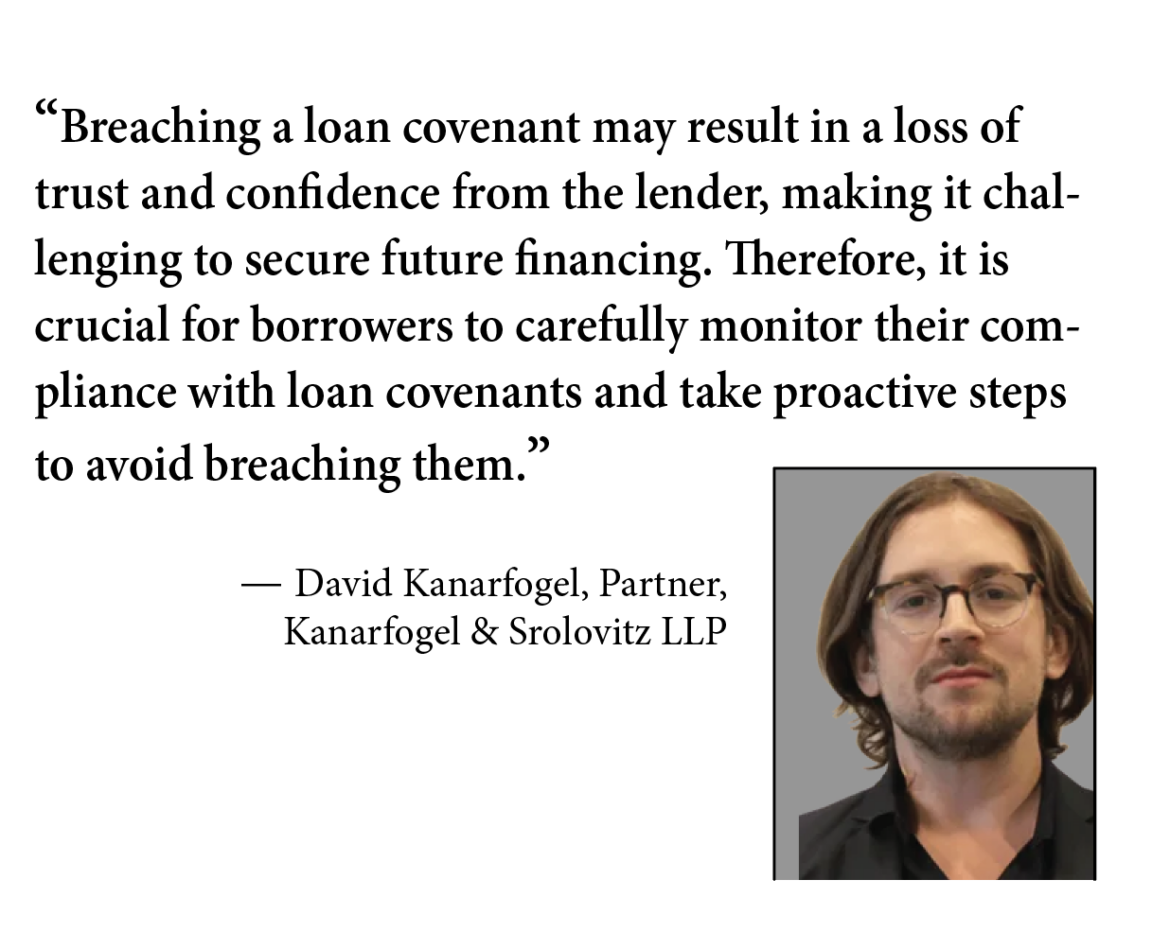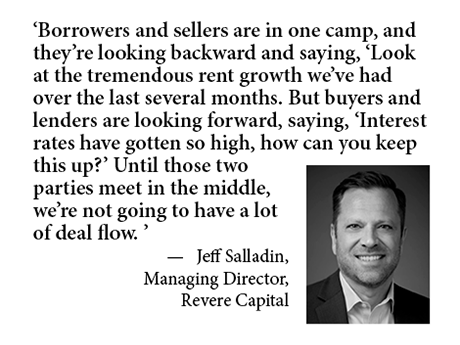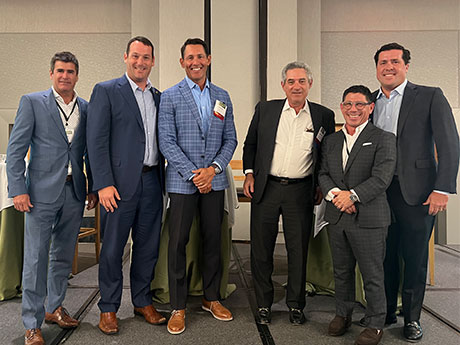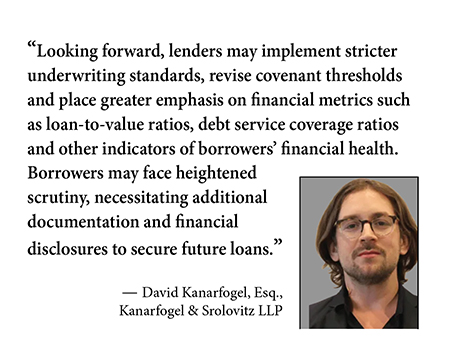No one in the multifamily sector needs a lecture on the difficulty of financing projects and deals these days. But, when there are challenges in the market, attention to detail and alternative financing can result in a better chance of finding solutions. Considering life insurance companies as viable investors is one example. Insurers often can provide needed liquidity as they search for yield, especially in the multifamily world. Multifamily fell to the same forces that have affected every other commercial real estate (CRE) class. After a buildup of easy money over more than a decade, the zero-interest rate policy in response to the pandemic collapse set asset investment on fire. Prices soared, opportunities were widespread and big leverage was in. “Starting in 2019/2020, you saw a lot of floating-rate bridge money,” says Susan Mello, executive vice president and group head of capital markets at Walker & Dunlop. But as loans came up for refinancing, quick and large Federal Reserve hikes of the benchmark federal funds rate kicked up loan costs everywhere and made penciling a deal difficult, if not impossible. “The rapid rise of interest rates put values in question across the board. That’s exacerbated by how much liquidity there …
Features
By Channing Hamilton ATLANTA — Today’s seniors housing market is a tough one, characterized by an inflationary environment and high operational costs. Amid the challenges the industry currently faces, owner-operators within the sector must focus on controlling expenses, such as labor and insurance, to maintain profitability — and earlier is better when it comes to planning to mitigate these expenses. Eric Mendelsohn, CEO and president of National Health Investors, a REIT that specializes in seniors housing, emphasized the importance of labor market analysis in the underwriting stage of operations. “Labor is a key element of expense structure in the building,” he said. “Before, we could give it a cursory look. Now, it’s important to really drill down into a market. “We pay closer attention to labor expense and availability,” he continued. “We’ll see what our competitors are paying, and then see what other industries such as retail and fast food in the area are paying. If Target and TGI Fridays are unable to find labor, that’s an indicator that you’re going to have a problem.” Mendelsohn’s remarks came during the keynote address at the 10th annual InterFace Seniors Housing Southeast, a networking and information conference hosted by France Media’s InterFace …
By MaCauley Studdard In the last two-plus years, rent growth and net absorption have both reached new heights, fueled by record levels of demand as a result of surging e-commerce sales. While e-commerce sales growth and the ongoing operational trend of maintaining higher inventory volumes has provided a tailwind to industrial fundamentals, there is also a third critically important component of demand growth that could continue to have an outsized influence on the industrial market in the months and years ahead: onshoring supply chain operations. Understanding the broader dynamics behind the onshoring trend is important to accurately measure its influence on the industrial market. Slowing trade growth The rapid pace of growth in global trade has been one of the most significant economic trends of the last half century: the defining characteristic of modern economies. The percentage of the world’s economy attributed to international trade nearly doubled between 1973 and 2008, growing from approximately 30 percent to 59 percent. While international trade remains the single most influential factor in the global economy, that figure has remained somewhat static in the last 15 years. Several factors have contributed to slowing global trade growth, including: • Growing demand for skilled labor • …
COVID-19 laid bare many problems inherent in offshore supply chains and spurred widespread interest in reshoring manufacturing to the United States. As companies and communities explore site selection and expansion opportunities, they should remember that manufacturing profitability often hinges on tax strategy. Staging a comeback For the first time in decades, industry and the public sector are working to make American manufacturing competitive in a rapidly changing global marketplace. The recent enactments of the Inflation Reduction Act, the Bipartisan Infrastructure Law and the CHIPS and Science Act have directed billions of dollars into enhancing domestic manufacturing capacity. The semiconductor industry presents a high-profile case study. The United States holds 12 percent of the world’s semiconductor manufacturing capacity, eroded from 37 percent in 1990. The CHIPS Act’s $52 billion in federal funding is intended to strengthen domestic semiconductor manufacturing, design and research and reinforce the nation’s chip supply chains, fortifying the economy and national security along the way. Simultaneously, the United States is becoming a leading producer of electric vehicles and vehicle battery plants. Since 2021, announced U.S. investments in semiconductors and electronics exceed $166 billion, and announced U.S. investments in electric vehicles and battery manufacturing exceed $150 billion. Deciding where …
“Traditional wired and wireless networks are becoming faster and more reliable with each new standard on the market,” says Pavlov Media CEO Cory Douglas. “We’re seeing multifamily consumers extend these data networks well beyond the need for just for voice and video. There are all kinds of new demands on multi-dwelling units (MDUs) for integrating Internet of Things (IoT), life safety and power and water management systems into traditional data networks.” For more than 30 years, Pavlov Media has been the leading national provider of residential Wi-Fi service, and now, with Douglas as the company’s newly named CEO, Pavlov Media has plans to build on its success through its unique technology and its eye on the innovation required by multifamily’s evolving needs. Douglas, promoted to replace retiring founder and CEO Mark Scifres, says what sets Pavlov Media apart is its ability to rapidly implement broadband Wi-Fi and video solutions for any style of community, located in any part of the country. “That capability is really driven by the investments in our back office, technology and engineering workflows that we’ve developed over time,” Douglas explains. “It’s our goal to make the purchasing and deployment experience easy for our customers. It’s done …
By David Kanarfogel, Partner, Kanarfogel & Srolovitz LLP In anticipation of a potential credit crisis in commercial real estate finance, borrowers are well-counseled to be aware of various measures that lenders are taking to mitigate any surge in defaults, including an increased willingness to create loan workout options and offer complex credit solutions. In this article, attention will be given to another component of commercial credit that can trigger unexpected problems but that also affords opportunities to borrowers to positively differentiate themselves in a constrained credit environment: loan covenants. Commercial loan covenants are contractual provisions that borrowers agree to comply with as a condition of obtaining a loan. These covenants aim to protect lenders’ interests and ensure that borrowers maintain certain financial and operational standards throughout the loan term. Breaching a commercial loan covenant can have serious consequences for borrowers. When a covenant is breached, it typically triggers a default event under the loan agreement. The lender may have the right to accelerate repayment of the loan, demand immediate payment of outstanding principal and interest or take legal action to enforce the terms of the agreement. Breaching a covenant may also result in a loss of trust and confidence from …
Inflation may be a handy — and valid — excuse for escalated costs, but that doesn’t mean students will simply sigh, sign on the dotted line and move on with a lighter bank account when faced with today’s escalating rents. “There is no doubt that higher rental rates have significantly increased the expectations from our current and prospective residents,” says Jason Fort, executive vice president of Asset Living. Yardi’s National Student Housing report, released in the third quarter of 2023, noted June marked the fifth consecutive month of annual rent growth over 7 percent at the 200 universities it tracks. June logged a 7.2 percent growth. “Given that 2022 held the previous rent record for student housing, obtaining more than 7 percent growth off of previous record-high numbers is exceptional,” the report states. “The average rent per bed at Yardi 200 universities was $846 at quarter-end, a new all-time high.” “We have never seen leasing strength close to what we are currently experiencing,” says Tadros ‘Teddy’ Abdelmalek, national director of business development at Campus Life & Style. “Our industry normally provides steady rent growth of 2 percent to 4 percent per year with occupancies in the low 90s percentile-wise. For the …
As the pandemic lockdowns hammered offices and retail properties, investors abandoned those assets and plowed cash into apartments and warehouses, both of which witnessed robust rent growth and appreciation as the economy reopened. But in many cases, apartment investors tapped ultra-cheap, variable-rate financing to overpay for multifamily properties, expecting rental rates to continue to climb and help the deals pencil financially. While in large part rents have grown — albeit not at the same double-digit level seen during 2021 and early 2022 — buyers often made the deals with too much optimism and failed to account for potential risks or often, at least, underappreciated them. Now, not only has the debt on those multifamily assets become considerably more expensive in about a year’s time, but labor, insurance, taxes and other operating costs also have increased. As a result, financial cracks are emerging in the multifamily market, says Jeff Salladin, a managing director with Dallas-based private debt fund Revere Capital. What’s more, because of the typical 12-month apartment lease term, landlords are unable to pass those higher expenses onto tenants in a timely fashion, declares Salladin, leader of the firm’s real estate debt team. Even if multifamily owners could increase rents, …
ATLANTA — Charlie Jennings, chief development officer with Vero Beach, Fla.-based Harbor Retirement Associates, said he would challenge the “Stay alive until ‘25” mantra that some real estate professionals are touting amid today’s economic uncertainty. The phrase is a play on the late billionaire investor Sam Zell’s remarks amid the downturn in 1991 when he coined the mantra “Stay alive until ’95.” “I do not agree with that at all; that insinuates that we’re just going to sit on our hands as an industry and wait for somebody else to turn the lights back on,” said Jennings. “Our industry will continue to grow, push forward and be innovative, and build relationships outside the normal REIT and private equity model that we’ve all grown accustomed to.” Jennings’ remarks came during the development outlook panel at the 10th annual InterFace Seniors Housing Southeast, a conference hosted by France Media’s InterFace Conference Group and Seniors Housing Business on Wednesday, Aug. 16 at the Westin Buckhead in Atlanta. Todd Hudgins, senior vice president of senior living for Madison, Wisconsin-based ERDMAN, moderated the panel. Jennings went on to say that while it is tough to get a deal done right now, eventually it will get …
By David Kanarfogel, Esq., of Kanarfogel & Srolovitz LLP The commercial real estate industry is approaching a critical crossroad as concerns intensify regarding a potential wave of loan defaults. The implications of such defaults and the legal mandates and guidelines that may emerge in response are of critical importance for commercial borrowers. This is because lenders could introduce new types of credit offerings and provide examples of loan workout activities that can help commercial owners and developers effectively navigate these interesting times. To comprehend the potential impact of loan defaults, it is crucial to grasp the current landscape of commercial lending. Over the past few years, lending in the industry has experienced a surge, resulting in a substantial number of loans approaching maturity. However, economic uncertainties and market volatility brought about by the pandemic, historic inflation and the fickle interest rate outlook have heightened concerns about borrowers’ ability to fulfill their loan obligations — and about what the next steps will be for both lenders and borrowers. Added to that are slowed growth or even reductions in property valuations, which complicates the underwriting for such loans, and with that the prospects for refinance, sale or other credit options that borrowers …











